An overflowing septic tank or cesspool will make even the most comfortable home completely uninhabitable. Therefore, all homeowners have to maintain both local and autonomous systems, pumping out excess drains from time to time. But what if the septic tank or cesspool fills up too quickly? Let's see how to solve this problem.
There is only one reason for this - the soil no longer absorbs water, which fills the sump tank or goes into the filtration field (if any). At the same time, the refusal of the soil to accept effluents has several explanations, namely:
- Due to insufficient activity the bottom layer of a septic tank or pit covers a silty sediment that forms a buffer film that prevents contact between soil and water. As a result, your cesspool or septic tank quickly fills up, since the liquid does not go anywhere, but remains in the tank.
Silting of the bottom in a septic tank
- The walls and bottom of the septic tank or pit are covered with grease and soap deposits, the source of which is kitchen drains. If you don’t, then you shouldn’t even be surprised at how quickly the septic tank fills up. Fat sediment clogs the drainage channels and blocks the exit of water through the bottom, overflows or through the side windows in the body of a homemade septic tank.
|
|
In some cases, sparingly soluble fat and soapstone clog the entire inner surface of the sewer pipe, completely stopping the flow of effluents to the sump or cesspool.
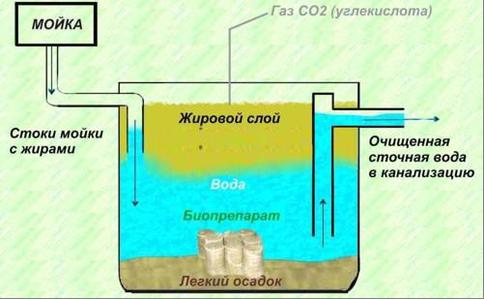
- The sewer just can't handle the waste. By must be at least three days of water consumption. Accordingly, an increase in the load on the water supply (more residents spend more water) leads to the fact that the septic tank fills up quickly - the liquid simply does not have time to go into the ground
- The soil just freezes, and frozen soil does not accept water under any circumstances. In addition, sometimes an ice plug appears in the septic tank or sewer pipe, blocking the movement of drains.
Now that the reasons for the failure of the sewerage system have been established, we just have to figure out what to do if the cesspool or septic tank fills up quickly. Therefore, further we will analyze the most effective ways to counteract the specific causes of failure of a local or autonomous waste disposal system.
Restoring the absorption capacity of the soil
This method is relevant only for owners of cesspools and homemade open-bottom septic tanks. In this case, to restore the absorbency of the soil, you will have to flush the sewer, and this is done as follows:
- We call a sewer and pump out the contents of a cesspool or septic tank.
- We fill the container, but not with fecal sewage, but with clean water.
- We let the water stand for a day, during which we do not use chlorine-containing preparations (detergents and cleaners) under any pretext.
- or biological products with an increased dose of such microorganisms. If it is recommended by the drug manufacturer, we repeat the procedure for 5-7 days.
The meaning of these actions is to liquefy the bottom silt with clean water and start intensive anaerobic and aerobic fermentation, which eats even the caked sediment. There is no need to re-vacuum the septic tank after this procedure, but throughout the year you will need to use a fresh batch of bacteria every month, necessary to maintain fermentation.
As a starting drug, we can recommend the following options:
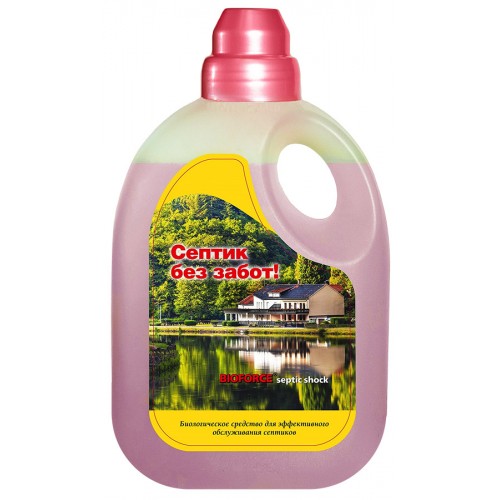
Remember that active biological products alone will not fix the situation - you will have to give up the frequent use of household chemicals. Otherwise, your septic tank will again become clogged with silt.
Remove grease and soap residue
In factory closed-bottom septic tanks, the main reason for the rapid filling of the sump tank is the formation of fatty or soapy deposits that impede the movement of liquid precipitation through the overflow channels. However, soap and grease plugs can also form in makeshift sewers. Moreover, the very fact of their occurrence is only a matter of time if there is no grease trap or a separate sump for kitchen drains in the sewer.
To remove soap and grease plugs, you can use two methods - mechanical and chemical. At the same time, the second option works much more efficiently than the first and is implemented without any effort.
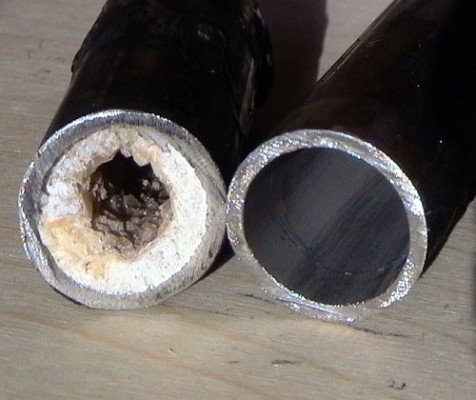
soapstone
To do this, pour the desired bactericidal preparation into the sinks, toilet and bathroom. And repeat this procedure until the throughput of the sewerage and overflows is restored.
In practice, it looks like this:
- We pump out the septic tank. We fill it with water. Let the water settle so that the chlorine evaporates from the liquid.
- Pour preparations into sinks, bathrooms and toilets that can destroy soap and grease deposits.
- We begin to use the sewerage system, monitoring the throughput of pipes and the water level in the septic tank. If necessary, fill in an additional portion of the drug.
- After restoring the capacity of the overflow channels, we introduce supporting cultures that can absorb fat deposits.
As a preparation for removing soap and grease, you can use the following options:
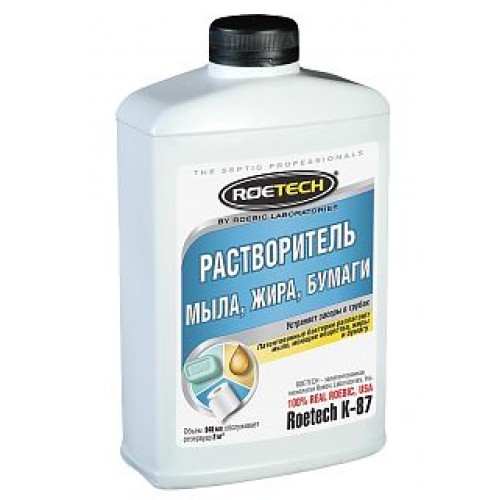
No drugs can solve the problem of insufficient power of the septic tank. If the daily discharge of water exceeds 1/3 of the volume of the sump, then building a well or filtration field is an almost inevitable step, an alternative to which would be only the dismantling of the old septic tank and the installation of a new treatment plant.
drainage well
The basis of such a structure is a shallow mine of 3-4 meters, dug to the sandy layers of soil. Usually it comes off at a distance of up to 5 meters from the septic tank and is connected to the sump by a separate pipeline with a diameter of 110-150 millimeters. The pipe should go under a slope (towards the well), with a height difference of 2 centimeters per linear meter of the line.
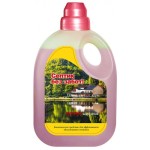
The walls of the drainage well are reinforced with concrete rings, the lower of which will have to be perforated by drilling many holes in its body with a diameter of 15-20 millimeters. Clarified water from the septic tank overflows into the well and goes into the sandy horizon of the soil.
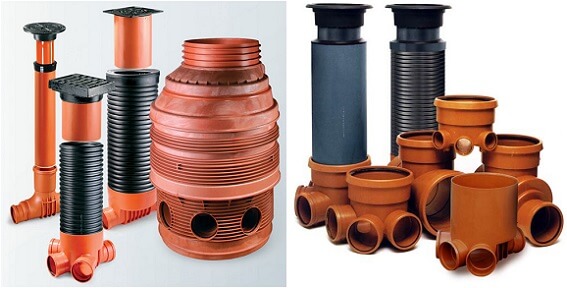
An alternative option is a drainage well made of polymer, assembled by 2-3 people from plastic parts (bottom, ring with bends for the pipeline, telescopic neck).
Filter field
This is a larger system, consisting of a perforated pipeline buried a meter deep into the ground. Moreover, perforated pipes are laid on sand and gravel bedding with a thickness of 25 centimeters and covered with the same mixture.
It involves digging a trench, placing bedding on its bottom and laying pipes. After the pipeline is assembled, it is covered with a 20-cm layer of sand and gravel bedding. In the final, the trench is covered with selected soil.
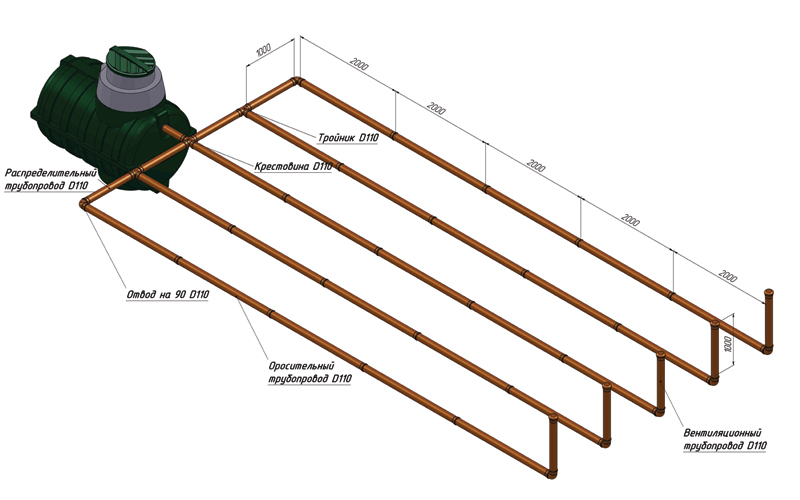
The pipeline of the filtration field runs at a slope of 2.5 centimeters per linear meter, so the depth of the trench can vary from 1 to 1.5 meters. As a rule, at least 8 linear meters of the pipeline of the filtration field are allocated per user, therefore, the owners of volumetric septic tanks dig not one trench, but several, placing 5 or 10-meter sections parallel to each other.
We improve the thermal insulation of pipes and septic tanks
The problem of ice jams does not arise from scratch. Usually, owners of home-made septic tanks suffer from this, having ignored the recommendations for deepening the structure below the freezing level of the soil. In addition, an ice plug appears in pipes devoid of external thermal insulation.
To eliminate the ice plug in the pipes, you will have to do the following:
- Rent or buy a steam generator and melt the ice plug in the pipeline.
- Buy and install a cylindrical
- Use modern solutions, such as -
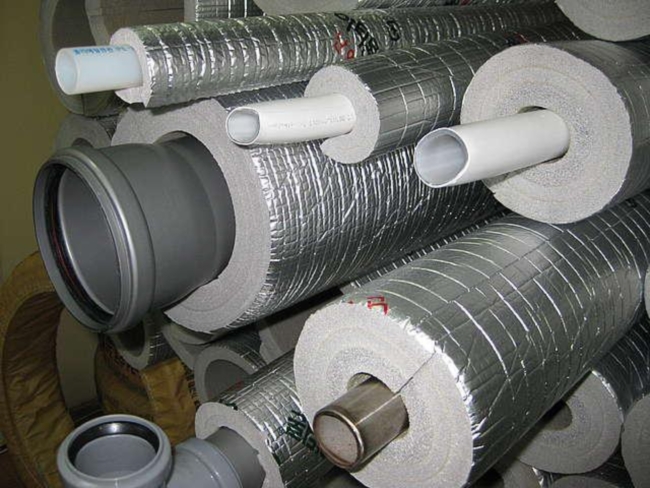
Stories about electricity, pins and hooks are a sure way to a hospital bed. The effectiveness of homemade "boilers" is questionable, and the risk of electric shock is more than real.
Melting ice in a pipe with hot water will result in an inevitable “return” of liquid flowing out of the pipe after contact with the fecal plug. It is collected in a separate bucket, but the smell will not go anywhere, and it will take a very long time to spill the cork with hot water. That is why the only acceptable tool for breaking the ice plug is the steam generator.
If the plug has grown in the septic tank, binding the surface of the drains, then in this case you will have to do the following:
- We open the hatch, drill several holes in the ice, getting to the liquid.
- We melt the ice plug with hot steam using a rented or purchased steam generator. Moreover, our task is only to break the crust into separate ice floes.
- After the destruction of the ice crust, it pumps out fecal effluents, and pour hot water into the septic tank, which will melt the remaining ice. If necessary, repeat this procedure.
- Pour preparations into the septic tank or, which will start the fermentation process in the container.
- We make fires around the perimeter of the septic tank, warming the earth to the desired depth.
- We fill the coals of fires with sand and cover the ground with some kind of heat insulator, such as expanded clay or sawdust, or foam plastic slabs. Moreover, the bedding will have to be laid not only on top of the septic tank, but around it, at a distance of one meter from the walls.
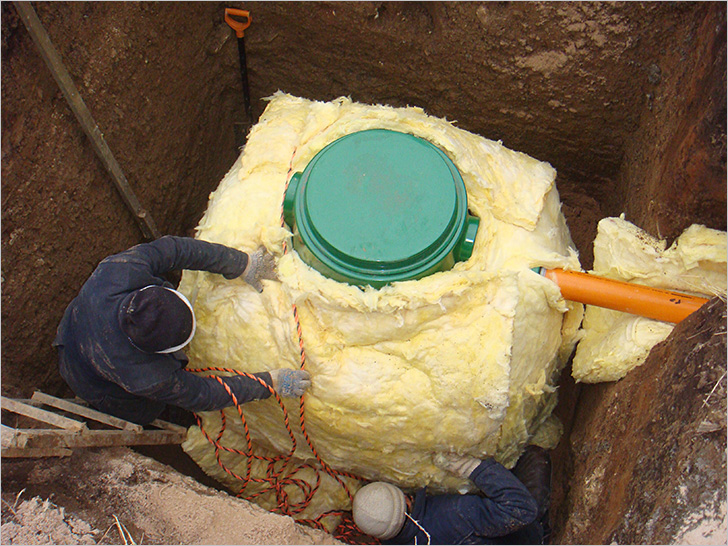
Bacteria launched into the septic tank will start the fermentation process, accompanied by the release of heat. Backfilling on the lid of the septic tank and along its perimeter will change the depth of soil freezing in this area, eliminating the cause of the formation of an ice plug in the septic tank. After completing these works, you can use the septic tank without fear of encountering another ice plug.


















